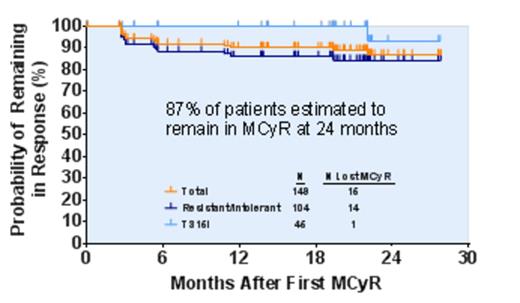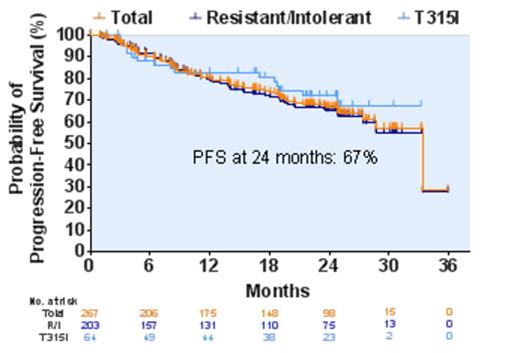Abstract

Background: Ponatinib is an approved potent oral tyrosine kinase inhibitor (TKI) active against native and mutant BCR-ABL, including the resistant T315I mutant.
Methods: The PACE trial (NCT01207440) evaluated efficacy and safety of ponatinib (45mg qd) in CML and Ph+ ALL patients (pts, N=449) resistant/intolerant to dasatinib or nilotinib or with the T315I mutation. In Oct 2013, the trial was placed on partial clinical hold due to observation of arterial thrombotic events (ATEs) in the ponatinib clinical program, following which dose reductions were recommended. We report long-term follow-up analysis (minimum 23.9 month follow-up from last patient, first visit). For ATEs, exposure adjusted yearly incidence rates were calculated as (number of pts with first event in interval)/(total exposure for the interval)*100 [AEs per 100 pt years (AE/100 PY)]. Rates for later intervals exclude pts with prior events.
Results: Pts were heavily pretreated: 58% received ≥3 prior TKIs. As of Jan 6, 2014, median follow-up: 27.9 (0.1-39.5) months, 38% (50% chronic phase (CP)-CML) pts ongoing. Most common reasons for discontinuation: progressive disease (21%) and adverse events (AEs) (15%; most common was thrombocytopenia, 4%). Response rates are shown in the Table. For CP-CML pts, 2-year major cytogenetic response (MCyR) duration, PFS, and OS estimates were 87%, 67%, and 86%, respectively (Figure). For accelerated-phase (AP) CML, blast-phase (BP) CML, and Ph+ ALL, estimated OS [PFS] at 2 years was 72% [39%], 18% [11%], and 18% [NA], respectively. 64% CP-CML pts had ≥1 dose reduction within the first year to manage AEs; responses were generally maintained after dose reduction: 99% maintained MCyR; 96% maintained complete cytogenetic response (CCyR), and 90% maintained major molecular response (MMR). Frequent (≥20%) treatment-emergent AEs were thrombocytopenia (44%), abdominal pain (41%), rash (41%), constipation (37%), headache (37%), dry skin (35%), fatigue (29%), pyrexia (29%), nausea (28%), arthralgia (28%), hypertension (26%), neutropenia (25%), anemia (22%), myalgia (21%), diarrhea (21%), vomiting (21%), increased lipase (21%). Most-common serious AEs (SAEs) were pneumonia (7%) and pancreatitis (6%). ATEs [serious ATEs] were observed in 19% [14%] pts and included cardiovascular 10% [7%], cerebrovascular 7% [5%], peripheral vascular 7% [4%] events. Venous thromboembolic events (VTEs) were observed in 5% pts [considered serious in 3%]. Higher dose intensity, older age, and cardiovascular risk factors were associated with higher likelihood of ATEs. At the time of analysis exposure adjusted incidence rates of newly-occurring ATEs were: year 1: 15.1 AE/100 PY; year 2: 13.8 AE/100 PY; year 3: 8.5 AE/100 PY; and newly-occurring VTEs were: year 1: 3.5 AE/100 PY; year 2: 1.9 AE/100 PY; year 3: 1.2 AE/100 PY. Analysis with complete 3 year data will be presented.
Following dose reduction recommendations, as of Apr 7, 2014, 44% pts had their dose reduced; 36% were maintained on prior dose. Between Oct 2013 and Apr 2014, no patient lost MCyR, 1 patient lost MMR, and 1 patient had a first serious ATE after dose reduction. Two additional pts had a first serious ATE while maintaining dose. OS estimate at 2 years was not reduced in pts with ATE (86%) vs without ATE (86%); MCyR in CP-CML pts with vs without an ATE was 69% vs 53%. Updated data will be presented.
Conclusions: Ponatinib continues to exhibit deep and durable responses in heavily pretreated pts with longer follow-up, particularly CP-CML. A dose reduction strategy was implemented in response to the observation of ATEs. Initial data show responses are maintained after dose reduction; longer follow-up is needed to understand impact on safety. A dose-ranging trial of ponatinib in refractory CML to evaluate benefit/risk is being planned.
Responses at Any Time
| R/I, n (%) | T315I, n (%) | Total, n (%) | |
| CP-CML | N=203 | N=64 | N=267 |
| MCyR | 112 (55) | 46 (72) | 158 (59) |
| CCyR | 97 (48) | 45 (70) | 142 (53) |
| MMR | 65 (32) | 37 (58) | 102 (38) |
| MR4 | 43 (21) | 25 (39) | 68 (26) |
| MR4.5 | 32 (16) | 21 (33) | 53 (20) |
| AP-CML | N=65 | N=18 | N=83 |
| MaHR | 40 (62) | 11 (61) | 51 (61) |
| BP-CML | N=38 | N=24 | N=62 |
| MaHR | 12 (32) | 7 (29) | 19 (31) |
| Ph+ ALL | N=10 | N=22 | N=32 |
| MaHR | 5 (50) | 8 (36) | 13 (41) |
| MR4, molecular response 4;MR4.5, molecular response 4.5; MaHR, major hematologic response MR4 and MR4.5 defined as ≤0.01% and ≤0.0032% ratio of BCR-ABL to ABL transcripts on the international scale | |||
| R/I, n (%) | T315I, n (%) | Total, n (%) | |
| CP-CML | N=203 | N=64 | N=267 |
| MCyR | 112 (55) | 46 (72) | 158 (59) |
| CCyR | 97 (48) | 45 (70) | 142 (53) |
| MMR | 65 (32) | 37 (58) | 102 (38) |
| MR4 | 43 (21) | 25 (39) | 68 (26) |
| MR4.5 | 32 (16) | 21 (33) | 53 (20) |
| AP-CML | N=65 | N=18 | N=83 |
| MaHR | 40 (62) | 11 (61) | 51 (61) |
| BP-CML | N=38 | N=24 | N=62 |
| MaHR | 12 (32) | 7 (29) | 19 (31) |
| Ph+ ALL | N=10 | N=22 | N=32 |
| MaHR | 5 (50) | 8 (36) | 13 (41) |
| MR4, molecular response 4;MR4.5, molecular response 4.5; MaHR, major hematologic response MR4 and MR4.5 defined as ≤0.01% and ≤0.0032% ratio of BCR-ABL to ABL transcripts on the international scale | |||
Cortes:ARIAD Pharmaceuticals, Inc., BMS, Novartis, Pfizer, Teva: Consultancy, Research Funding. Kim:ARIAD Pharmaceuticals, Inc.: Research Funding. Pinilla-Ibarz:Novartis, ARIAD, BMS, Pfizer: Speakers Bureau; Novartis, ARIAD: Research Funding. Le Coutre:ARIAD Pharmaceuticals, Inc., Novartis, BMS, Pfizer: Honoraria. Paquette:Novartis, BMS, ARIAD: Consultancy, Honoraria, Speakers Bureau. Chuah:Novartis, BMS: Honoraria. Nicolini:Novartis, BMS, ARIAD: Consultancy, Membership on an entity's Board of Directors or advisory committees, Research Funding, Speakers Bureau. Apperley:ARIAD Pharmaceuticals, Inc., BMS, Novartis, Pfizer: Membership on an entity's Board of Directors or advisory committees, Speakers Bureau. Khoury:ARIAD Pharmaceuticals, Inc.: Honoraria, Research Funding. Talpaz:ARIAD Pharmaceuticals, Inc., BMS, Sanofi, Incyte, Pfizer: Research Funding. DeAngelo:ARIAD, Novartis, BMS: Consultancy. Abruzzese:Novartis, BMS, ARIAD, Pfizer: Consultancy. Rea:Novartis, BMS, Pfizer, ARIAD: Honoraria. Baccarani:ARIAD, Novartis, BMS: Consultancy; ARIAD, Novartis, BMS, Pfizer, Teva: Honoraria; ARIAD, Novartis, BMS, Pfizer, Teva: Speakers Bureau. Müller:Novartis, BMS, ARIAD: Consultancy, Honoraria, Research Funding. Lustgarten:ARIAD Pharmaceuticals, Inc.: Employment, Equity Ownership. Rivera:ARIAD Pharmaceuticals, Inc.: Employment, Equity Ownership. Clackson:ARIAD Pharmaceuticals, Inc.: Employment, Equity Ownership. Turner:ARIAD Pharmaceuticals, Inc.: Employment, Equity Ownership. Haluska:ARIAD Pharmaceuticals, Inc.: Employment, Equity Ownership. Guilhot:ARIAD Pharmaceuticals, Inc.: Honoraria. Deininger:BMS, Novartis, Celgene, Genzyme, Gilead: Research Funding; BMS, ARIAD, Novartis, Incyte, Pfizer: Advisory Board, Advisory Board Other; BMS, ARIAD, Novartis, Incyte, Pfizer: Consultancy. Hochhaus:ARIAD Pharmaceuticals, Inc.: Research Funding. Hughes:Novartis, BMS, ARIAD: Honoraria, Research Funding. Shah:ARIAD Pharmaceuticals, Inc., BMS: Research Funding. Kantarjian:ARIAD Pharmaceuticals, Inc., Pfizer, Amgen: Research Funding.
Author notes
Asterisk with author names denotes non-ASH members.

This icon denotes a clinically relevant abstract




This feature is available to Subscribers Only
Sign In or Create an Account Close Modal